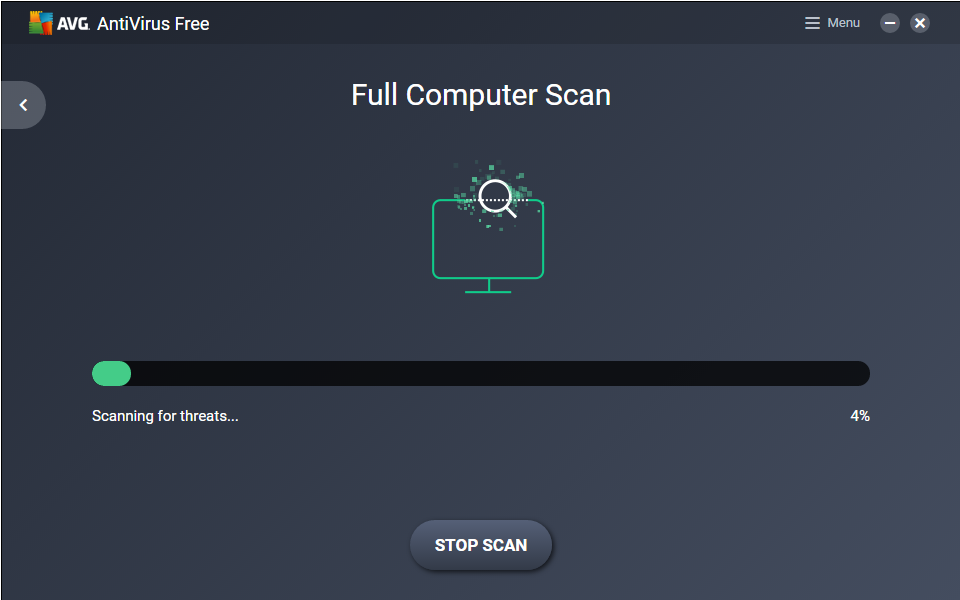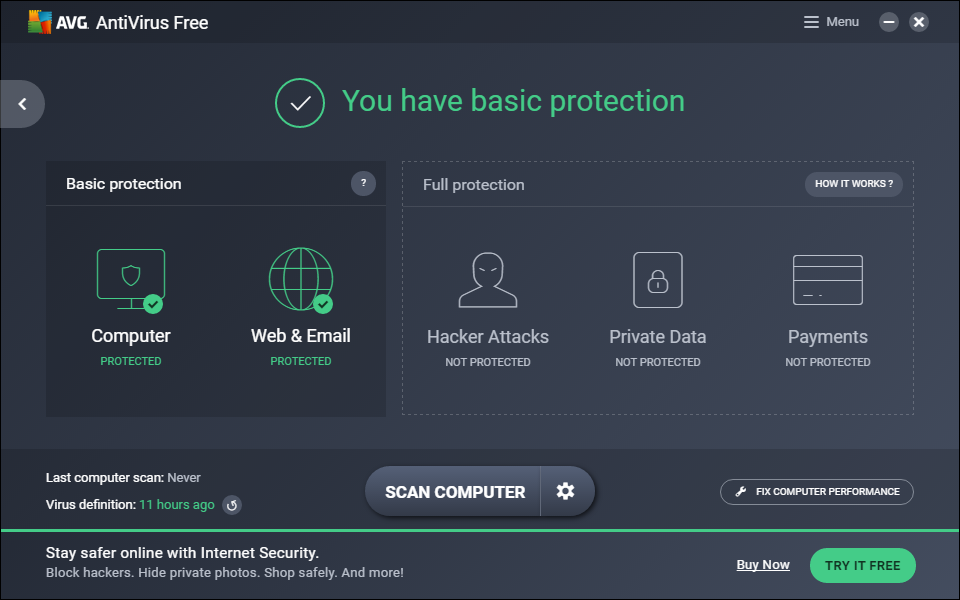Our team is always looking for things we think our readers will value. We have received compensation for publishing this article.
Fake virus alerts are a common yet dangerous weapon often used by cybercriminals. These alerts masquerade themselves as legitimate security warnings, tricking users into actions that end up compromising their own digital safety. From installing invasive malware to unintentionally handing over sensitive data, the consequences of falling for such scams are severe and far-reaching.
To prevent these, having a dependable antivirus installed becomes your only shield. AVG Antivirus Free stands out by offering powerful, no-cost protection that will shield you from the deceptive tactics of these dangerous online threats. By equipping yourself with AVG Antivirus Free, you ensure that your digital environment remains secure, safekeeping your data from any unscrupulous cyber-criminal. Do you want to know how?
Decoding Fake Virus Warnings: What You Need to Know
What Are Fake Virus Alerts?
Fake virus alerts are cleverly disguised threats that appear as legitimate warnings from trusted cybersecurity sites. These alerts often claim to detect viruses or security breaches on your device and prompt you to take immediate action. Recent developments in scam tactics have seen a significant uptick in the realism of these alerts, employing high-quality visuals that mirror actual updates from well-known real antivirus software, making them difficult to recognize at first glance.
How do Fake Virus Alerts Work?
Understanding how these scams operate is key to defending against them. At their core, fake virus alerts are specifically engineered to exploit the natural human response to danger, especially with the sudden increase of online perils. Scammers design these alerts to incite panic, often suggesting that immediate action is necessary to prevent dire consequences, such as data loss or identity theft.
In the typical scenario, an alert may pop up while browsing, warning of multiple viruses supposedly found on your device. It might urge you to click a link to remove these threats instantly. However, doing so is a clever trick that could install malware or ransomware on your device. This tactic, known as scareware, leverages the shock factor to cloud judgment, bypassing rational thinking and provoking hasty decisions that can have serious security repercussions.
To combat these sophisticated threats, AVG AntiVirus FREE offers a powerful line of defense with its advanced detection algorithms and real-time protection features. It scans and monitors your device continuously, alerting you to any genuine threats while distinguishing between real dangers and fabricated alerts. By providing clear and reliable notifications, AVG Antivirus Free ensures that users can confidently navigate their digital lives without fear of falling prey to these deceptive tactics. Whether you’re browsing online, downloading new applications, or checking emails, AVG AntiVirus FREE stands as a vigilant protector, keeping your digital environment safe and secure from the deceptive designs of cybercriminals.

Unmasking the Different Types of Fake Virus Alerts
Pop-Up Warnings: A Persistent Nuisance
Pop-up warnings are the most common form of fake virus alerts, often appearing while you peacefully browse the web. These pop-ups may mimic the layout and language of legitimate software updates, falsely claiming that your device is at risk. Recent shifts in scamming tactics have seen an evolution in these pop-ups, adding more convincing graphics and urgent call-to-action buttons that mimic those of real antivirus notifications. These can include fake prompts for immediate software updates, virus removal, or even system cleanups. If done so, the scammers usually install all kinds of malware or ransomware in your device.
Malvertisements: When Ads Turn Malicious
Another insidious technique involves malvertisements. These are seemingly harmless advertisements placed on legitimate advertising networks, which are unknowingly laced with malicious code. Cybercriminals exploit these platforms to broadcast fake virus alerts broadly. Clicking on these ads can lead to downloading and installing malware or redirecting users to phishing sites. The challenge lies in their placement on reputable sites, making them appear trustworthy at first glance. AVG AntiVirus FREE’s Web Shield technology scans and blocks these malicious ads before they can do any harm, providing an essential layer of protection.
Fake System Notifications: The Art of Deception
Fake system notifications are crafted to replicate the alerts from your operating system. These notifications may pop up in the system tray or as banners, warning of detected malware or security breaches. Normally, these are so well crafted that telling apart fake from real is almost impossible. These include slight discrepancies in font, wording, and layout—details that are often overlooked in a moment of panic. Being familiar with the genuine alerts of your operating system can help in identifying these fakes.

Emerging Threats: Staying Ahead of Scammers
Recently, cybercriminals have begun employing more sophisticated methods such as fake background applications or security tool updates that once clicked, may run harmful processes covertly. Additionally, scammers are using AI-driven techniques to create more personalized and context-aware fake alerts, which can adapt based on the user’s browsing history or previously installed software. AVG AntiVirus FREE stays updated with the latest threat definitions and employs advanced detection algorithms to counter these evolving scams, keeping your digital environment secure.
Proactive Defense Features in AVG AntiVirus FREE
AVG AntiVirus FREE is equipped with a suite of tools designed to provide comprehensive protection for your digital life. These bring real-time protection, email and web shield technology, a powerful software updater and a helpful do not disturb mode. Let’s take a closer look at them.
Regular Scans and Real-Time Protection
AVG AntiVirus FREE offers continuous protection against threats by running in the background of your device at all times. This real-time protection detects and blocks malware before it can inflict any damage to your devices. To complement this, AVG also encourages regular full system scans that ensure that no hidden threats exist, maintaining the overall integrity and health of your computer.
Browser and Download Monitoring
AVG AntiVirus FREE enhances your safety with dedicated monitoring and analysis of downloads, attachments, and links. This feature checks all files you download and the links you click, guarding against the accidental introduction of malware or fake virus alerts that appear legitimate.
Enhancing Browser Security
With AVG’s Web Shield technology, your online browsing becomes safer. This technology actively blocks fake pop-ups and redirects from websites known for distributing scareware or engaging in phishing. Web Shield seamlessly integrates with your browser, adding an additional layer of security that filters out harmful content before it reaches you.
Network and Email Security
AVG AntiVirus FREE also secures your network and email interactions. Its network security features are vital when connecting to both home and public Wi-Fi networks, shielding your device from threats that try to infiltrate through these connections. Additionally, the Email Shield feature specifically targets risky email attachments and phishing attempts—common tactics used to spread scareware.
Software Updates and Patches
Keeping your software up to date is essential in defending against the latest threats. AVG’s Software Updater proactively notifies you of available updates for your installed software and can automate the update process. This not only helps protect against vulnerabilities that could be exploited by new variants of malware but also ensures your OS won’t suffer the intrusion of malware distributed via fake virus alerts.
AVG’s Do Not Disturb Mode
This unique feature ensures that you are not interrupted by notifications or updates while you use selected full-screen applications, like games or movies, thus enhancing your experience without compromising security.

Step-by-Step Guide to Handling Fake Alerts with AVG AntiVirus FREE
Immediate Actions: What to Do When You Encounter a Suspected Fake Alert
- Do Not Interact: The first and most crucial step is to avoid interacting with the alert. Do not click on any part of the popup, including the “close” button, as it may be programmed to trigger malware installation.
- Safely Close Your Browser: To safely close your browser, use the task manager on your computer. For Windows, you can press Ctrl+Shift+Esc to open the task manager, find your browser in the list of running applications, and click ‘End Task.’ On a Mac, you can use Cmd+Opt+Esc to bring up the force quit applications window and then select your browser and click ‘Force Quit.’
- Disconnect from the Internet: Turn off your Wi-Fi or unplug your Ethernet cable. Temporarily disconnecting from the internet will prevent the further download of malware and cut off communication with the attacker’s server.
- Run a Scan with AVG AntiVirus FREE: Once your browser is closed and you are disconnected from the internet, run a full system scan with AVG AntiVirus FREE. This will help identify and remove any malicious software that might have been activated or installed without your knowledge.
Confirming the Legitimacy of an Alert
- Perform a Web Search: Use a smartphone or another device to search for the exact wording of the alert or the name of the product it is pushing. Look for information from reputable tech websites or forums where others might have reported similar experiences. You will usually see similar experiences where other users will confirm the illegitimacy of the alert.
- Check Official Sources: Visit the official website of the software or security service you use by typing the URL directly into your browser instead of clicking on any links from the alert itself. Check for any notices or information that match the details in the alert you received.
- Contact Support: If still in doubt, contact the customer support of the software or security service directly. Use the contact information from their official website and inquire about the alert you received to confirm whether it was a legitimate warning or a fake.
- Update Your Security Software Manually: Ensure that your antivirus and other security software are up to date. These updates often include patches for new vulnerabilities that could be exploited by attackers to generate fake alerts.

The Critical Role of Caution Against Fake Virus Alerts
Vigilance is key, especially with the increasing number of cyber threats like fake virus alerts. These deceptive tactics, designed to exploit vulnerabilities both technical and human, emphasize the need for robust cybersecurity measures. AVG AntiVirus FREE stands as a crucial ally in this ongoing battle, offering comprehensive tools like real-time protection, Email Shield, and Web Shield. These features ensure that you’re not only alerted to potential threats but also protected from them before they can cause any harm. With AVG AntiVirus FREE you can confidently navigate the internet, safeguard your personal information, and avoid any pitfalls set by cybercriminals. Don’t let fake virus alerts compromise your safety and download your copy of AVG AntiVirus FREE right now.
Advertisement
Source link
lol

